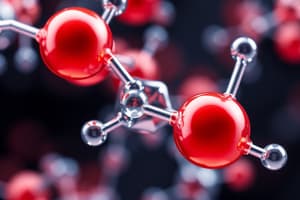Podcast
Questions and Answers
Which biological process involves the binding of extracellular signaling molecules and ligands to receptors?
Which biological process involves the binding of extracellular signaling molecules and ligands to receptors?
- Signal transduction pathways (correct)
- Genome
- Transcriptome
- Proteome
What component of the cell surface or inside the cell triggers events inside the cell in response to extracellular signaling molecules?
What component of the cell surface or inside the cell triggers events inside the cell in response to extracellular signaling molecules?
- Protein product (correct)
- Transcription
- DNA/RNA
- Proteome
Which field of study involves the molecular basis of life?
Which field of study involves the molecular basis of life?
- Chemistry of life (correct)
- Acids and amino acids
- Organic chemistry
- Biomolecules
What is responsible for stress-induced DNA modifications and errors that can lead to mutations?
What is responsible for stress-induced DNA modifications and errors that can lead to mutations?
What type of amino acids interact with water due to their properties?
What type of amino acids interact with water due to their properties?
In terms of biological information, what does the term 'Life adapts and evolves' refer to?
In terms of biological information, what does the term 'Life adapts and evolves' refer to?
What is the key function of enzymes in sustaining the living state at the molecular level?
What is the key function of enzymes in sustaining the living state at the molecular level?
Which molecule is highlighted as the primary source of energy at the molecular level?
Which molecule is highlighted as the primary source of energy at the molecular level?
What is the main function of the membrane surrounding cells?
What is the main function of the membrane surrounding cells?
What does the genome of an organism primarily consist of?
What does the genome of an organism primarily consist of?
In the context of living organisms, what is metabolism defined as?
In the context of living organisms, what is metabolism defined as?
What are the common chemical elements found in all living organisms according to the text?
What are the common chemical elements found in all living organisms according to the text?
Which type of molecules are synthesized by living organisms and are organic (carbon-based)?
Which type of molecules are synthesized by living organisms and are organic (carbon-based)?
What type of macromolecules are formed by linking certain biomolecules together?
What type of macromolecules are formed by linking certain biomolecules together?
Which of the following is NOT a common chemical element found in living organisms?
Which of the following is NOT a common chemical element found in living organisms?
What is the main characteristic of biomolecules according to the text?
What is the main characteristic of biomolecules according to the text?
Study Notes
Molecular Basis of Life
- Hundreds of biochemical reactions occur in a living organism to sustain life.
Metabolism and Homeostasis
- Metabolism is the sum of all biochemical reactions in a living organism.
- Homeostasis is the ability of an organism to maintain a relatively stable internal environment despite external and internal variability.
Energy Source
- Glucose is the primary source of energy for living organisms.
Cellular Structure and Function
- Cells are the basic units of living organisms, surrounded by a membrane that controls the transport of substances.
- Cells produce energy and are the matrix of life.
Cell Division and Genome
- Cell division is essential for growth and development.
- The genome is the genetic material of an organism, consisting of DNA (or RNA in RNA viruses).
Complexity and Dynamics of Life
- All organisms are composed of the same set of chemical elements (e.g., Carbon, Nitrogen, Oxygen, Hydrogen, Sulfur, and Phosphorous).
- Biomolecules are synthesized by living organisms and are organic (carbon-based) in nature.
Organization and Self-Sustenance of Life
- Living organisms are hierarchically organized from atoms to organisms.
- Biomolecules become linked to form polymers called macromolecules (e.g., nucleic acids, proteins, and polysaccharides).
Information-Based Life
- The genome includes both genes and non-coding sequences of DNA/RNA species.
- Signal transduction pathways involve the binding of extracellular signaling molecules and ligands to receptors, triggering events inside the cell.
Adaptation and Evolution
- Organisms adapt and evolve through stress-induced DNA modifications and errors during DNA replication, which can result in mutations.
- Mutations can contribute to an increased ability of the organism to survive, adapt, and reproduce.
Chemistry of Life
- The study of the molecular basis of life involves the study of biomolecules and their interactions with water.
- Hydrophilic, hydrophobic, and polar interactions are essential for biomolecule interactions.
Studying That Suits You
Use AI to generate personalized quizzes and flashcards to suit your learning preferences.
Description
Test your knowledge on the composition of living organisms, biomolecules synthesized by organisms, and living processes such as growth and development. Explore the elements found in all organisms and their roles in organic molecules.




